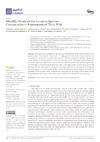Please use this identifier to cite or link to this item:
https://accedacris.ulpgc.es/jspui/handle/10553/114551
| DC Field | Value | Language |
|---|---|---|
| dc.contributor.author | Thorne-Bazarra, Thabatha | en_US |
| dc.contributor.author | Lozano-Bilbao, Enrique | en_US |
| dc.contributor.author | Triay Portella, Raül | en_US |
| dc.contributor.author | Hardisson, Arturo | en_US |
| dc.contributor.author | Paz, Soraya | en_US |
| dc.contributor.author | Rubio-Armendariz, Carmen | en_US |
| dc.contributor.author | Martín, Verónica | en_US |
| dc.contributor.author | Gutiérrez, Angel J. | en_US |
| dc.date.accessioned | 2022-05-03T10:52:54Z | - |
| dc.date.available | 2022-05-03T10:52:54Z | - |
| dc.date.issued | 2022 | en_US |
| dc.identifier.issn | 2076-3417 | en_US |
| dc.identifier.other | Scopus | - |
| dc.identifier.uri | https://accedacris.ulpgc.es/handle/10553/114551 | - |
| dc.description.abstract | Three toxic heavy metals (Cd, Pb, and Hg) were analyzed in the newly found invasive species in the Canary Islands, Cronius ruber. Its high growth rate and its widely varied diet are affecting the Canary marine ecosystem. The study was conducted using electrothermal vaporization atomic absorption spectrometry (GF-AAS) and cold-vapor atomic absorption spectrophotometry (CV-AAS). Significant differences were found in terms of the location and sex of the specimens, with the highest concentrations being found in areas with higher tourism activity and in the female specimens. On the other hand, the conclusion of the study is that human consumption of this species does not pose any toxic risk to public health, as the levels obtained in muscle tissue do not exceed the established limits for these metals. Therefore, its consumption and the fishing of this species can stop the proliferation of the same in the Canary coasts and thus not be harmful for the ecosystem. | en_US |
| dc.language | eng | en_US |
| dc.relation.ispartof | Applied Sciences (Basel) | en_US |
| dc.source | Applied Sciences (Switzerland) [EISSN 2076-3417], v. 12 (7), (Abril 2022) | en_US |
| dc.subject | 240119 Zoología marina | en_US |
| dc.subject | 3214 Toxicología | en_US |
| dc.subject | 230318 Metales | en_US |
| dc.subject.other | Canary | en_US |
| dc.subject.other | Cronius Ruber | en_US |
| dc.subject.other | Human Risk | en_US |
| dc.subject.other | Marine Invasive Species | en_US |
| dc.subject.other | Metal | en_US |
| dc.title | Metallic Study of the Invasive Species Cronius ruber—Assessment of Toxic Risk | en_US |
| dc.type | info:eu-repo/semantics/article | en_US |
| dc.type | Article | en_US |
| dc.identifier.doi | 10.3390/app12073217 | en_US |
| dc.identifier.scopus | 85127581422 | - |
| dc.contributor.orcid | NO DATA | - |
| dc.contributor.orcid | NO DATA | - |
| dc.contributor.orcid | NO DATA | - |
| dc.contributor.orcid | NO DATA | - |
| dc.contributor.orcid | NO DATA | - |
| dc.contributor.orcid | NO DATA | - |
| dc.contributor.orcid | NO DATA | - |
| dc.contributor.orcid | NO DATA | - |
| dc.contributor.authorscopusid | 57562466600 | - |
| dc.contributor.authorscopusid | 57196030841 | - |
| dc.contributor.authorscopusid | 55988833400 | - |
| dc.contributor.authorscopusid | 6603698084 | - |
| dc.contributor.authorscopusid | 57192703702 | - |
| dc.contributor.authorscopusid | 57221473285 | - |
| dc.contributor.authorscopusid | 57192392579 | - |
| dc.contributor.authorscopusid | 35324298300 | - |
| dc.identifier.eissn | 2076-3417 | - |
| dc.identifier.issue | 7 | - |
| dc.relation.volume | 12 | en_US |
| dc.investigacion | Ciencias | en_US |
| dc.type2 | Artículo | en_US |
| dc.utils.revision | Sí | en_US |
| dc.date.coverdate | Abril 2022 | en_US |
| dc.identifier.ulpgc | Sí | en_US |
| dc.contributor.buulpgc | BU-BAS | en_US |
| dc.description.sjr | 0,507 | |
| dc.description.jcr | 2,7 | |
| dc.description.sjrq | Q2 | |
| dc.description.jcrq | Q2 | |
| dc.description.scie | SCIE | |
| dc.description.miaricds | 10,5 | |
| item.fulltext | Con texto completo | - |
| item.grantfulltext | open | - |
| crisitem.author.dept | GIR ECOAQUA: Biodiversidad y Conservación | - |
| crisitem.author.dept | IU de Investigación en Acuicultura Sostenible y Ecosistemas Marinos (IU-Ecoaqua) | - |
| crisitem.author.orcid | 0000-0002-7591-6254 | - |
| crisitem.author.parentorg | IU de Investigación en Acuicultura Sostenible y Ecosistemas Marinos (IU-Ecoaqua) | - |
| crisitem.author.fullName | Triay Portella,Raül | - |
| Appears in Collections: | Artículos | |
SCOPUSTM
Citations
4
checked on Jun 8, 2025
WEB OF SCIENCETM
Citations
4
checked on Jan 12, 2026
Page view(s)
218
checked on Jan 15, 2026
Download(s)
131
checked on Jan 15, 2026
Google ScholarTM
Check
Altmetric
Share
Export metadata
Items in accedaCRIS are protected by copyright, with all rights reserved, unless otherwise indicated.
